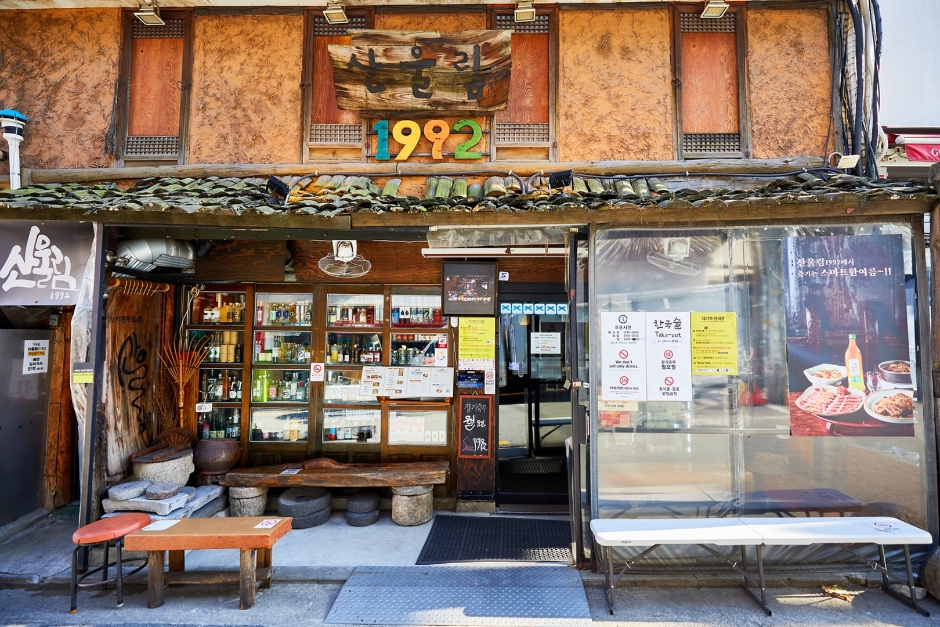Beanpole - Hyundai Sinchon Branch [Tax Refund Shop] (빈폴 현대 신촌점)
10.7Km 2024-04-19
83, Sinchon-ro, Seodaemun-gu, Seoul
-
Hyundai Department Store - Sinchon Branch [Tax Refund Shop] (현대백화점 신촌점)
10.7Km 2024-04-23
83, Sinchon-ro, Seodaemun-gu, Seoul
-
CheongKwanJang - Sinchon Station Branch [Tax Refund Shop] (정관장 신촌역)
10.7Km 2024-04-22
78, Sinchon-ro, Mapo-gu, Seoul
-
Sanullim 1992 (산울림1992)
10.7Km 2024-03-15
60 Seogang-ro 9-gil, Mapo-gu, Seoul
This Korean bar and restaurant serves Korean dishes with nearly 200 types of traditional Korean liquor on offer, including makgeolli (unrefined rice wine), refined rice wine, and distilled liquor. Its food menu includes bean curd with stir-fried kimchi, ox knee soup (soup made by boiling down calcium-rich ox knee), and cabbage wraps with soy sauce braised pork. The signature menu here, however, is “Bansang,” set menus of the customer's choice ranging from No. 1 to No. 5 served on a round dining table. Each number has a different pricing and composition, but all offer new and unique flavors. The savory and crispy cheese and potato pancake goes perfectly with tangy omija makgeolli.
Gwanghwamun Gate (광화문)
10.7Km 2024-12-04
161 Sajik-ro, Jongno-gu, Seoul
+82-2-3700-3900
Built in 1395 under the reign of King Taejo, the first king of the Joseon dynasty, Gwanghwamun Gate is the southern gate of Gyeongbokgung Palace. It is also the main gate of the palace, therefore larger and fancier in comparison to the other gates. Gwanghwamun Gate consists of three arched gates; the center gate was used by the king, while the other two were used by the crown prince and royal officials. The tall granite walls of the gate serve as a platform for the wooden gate tower that watches over the city. The gate has a sign with its name written at the top center of the gate tower.
Gwanghwamun Gate went through several damages and restorations over the course of history. It was first severely damaged during the Imjin War (1592-1598) and was not restored until the reconstruction of Gyeongbokgung Palace in 1864. Under the Japanese administration, the gate was demolished and relocated to the north of the palace's eastern gate, followed by series of damages during the Korean War (1950-1953). In 1968, Gwanghwamun Gate was relocated back to the south of the palace and was rebuilt using concrete; however, the gate’s position was shifted a few meters away from its original location. In 2006, a major reconstruction project took place to restore Gwanghwamun Gate to its original state and location, disassembling the structure completely and replacing concrete with granite and wood. After three years and eight months of construction, Gwanghwamun Gate was fully restored to its original form and was open to the public on August 15, 2010.
Gyeonghuigung Palace (경희궁)
10.7Km 2024-07-09
45 Saemunan-ro, Jongno-gu, Seoul
+82-2-724-0274
Gyeonghuigung Palace, a designated Historic Site, was originally called the large palace by Saemun Gate, or the Western Palace, for its location within the city. It was not until the eighth year of Gwanghaegun (1616) that the palace was used as a royal residence for the king, changing the name to Gyeongdeokgung Palace. The name later changed again to the current Gyeonghuigung Palace in 1760. The palace grounds included many halls but they were mostly all burned down in a fire in 1829. After the Japanese occupation began, all remaining buildings on the site were torn down and the palace grounds were turned into Gyeongseong Middle School (now Seoul High School). The school moved to Gangnam area in 1987, afterwhich the previous location was turned into a park. The palace grounds currently hold Seoul Museum of Art and walking paths, as well as a restoration of Heunghwamun Gate, the main gate of the palace, and Sungjeongjeon Hall, the main hall, completed in November 1994.
![Beanpole - Hyundai Sinchon Branch [Tax Refund Shop] (빈폴 현대 신촌점)](http://tong.visitkorea.or.kr/cms/resource/68/2890168_image2_1.jpg)
![Buru N Judy [Tax Refund Shop] (부루&주디)](http://tong.visitkorea.or.kr/cms/resource/71/2890871_image2_1.jpg)
![Hyundai Department Store - Sinchon Branch [Tax Refund Shop] (현대백화점 신촌점)](http://tong.visitkorea.or.kr/cms/resource/72/2890072_image2_1.jpg)
![Wonder Place [Tax Refund Shop] (원더플레이스)](http://tong.visitkorea.or.kr/cms/resource/81/3314681_image2_1.jpg)
![Tandy [Tax Refund Shop] (탠디)](http://tong.visitkorea.or.kr/cms/resource/18/3314418_image2_1.jpg)
![Ziozia [Tax Refund Shop] (지오지아)](http://tong.visitkorea.or.kr/cms/resource/59/3313259_image2_1.jpg)
![CheongKwanJang - Sinchon Station Branch [Tax Refund Shop] (정관장 신촌역)](http://tong.visitkorea.or.kr/cms/resource/46/2878346_image2_1.jpg)


 English
English
 한국어
한국어 日本語
日本語 中文(简体)
中文(简体) Deutsch
Deutsch Français
Français Español
Español Русский
Русский